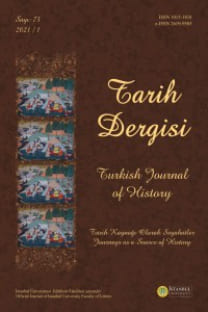Roma Mahkemelerinde Savunma Yapan “Avukat” Kadın
Cinsiyeti nedeniyle politik, hukuki ve ticari haklardan uzun süre mahrum bırakılan Romalı kadınlar, Kartaca Savaşları ve sonrasındaki tüm Akdeniz hâkimiyeti için yapılan savaşların doğurduğu bir sonuç olarak, erkek sayısındaki azalmayla birlikte birtakım avantajlar elde etme fırsatı yakalamıştır. Erkek nüfusundaki azalmayla birlikte neredeyse bütün işleri yapmak zorunda kalan Romalı kadınlardan bazıları, ticari hayatta ve istisnai bir şekilde de olsa hukuk mahkemelerinde varlık göstermiştir. Bu çalışmada, hukukun çoğunlukla elit erkeklerin alanı olarak görüldüğü Roma’da, bazı kadınların mahkemelerde kendileri ya da başkaları adına savunma yaptıkları davalar ele alınmaktadır.
Anahtar Kelimeler:
Hukuk, Roma Mahkemeleri, Avukat Kadınlar, Savunma, Roma Kadını
Female Attorneys in Ancient Roman Courts
Roman women were denied basic political, legal, and commercial rights. However, as a result of conflicts such as the Punic Wars for Mediterranean supremacy, the male population of Rome dropped, and women were able to take advantage of the situation. Some Roman women, who were essentially forced to perform all kinds of work because of this drop in male population, began to appear more frequently in commercial life and courts of law. In this study, we will examine cases where women defended themselves or others in the law courts of Rome, where legal activities had previously been solely the domain of elite men.
Keywords:
Law, Roman courts, women lawyers, legal defense, Roman women,
___
- App.: Appianus (of Alexandria), Appian’s Roman History, IV, çev. Horace White, The Loeb Classical Library, London 1913.
- Gel.: Aulus Gellius, The Attic Nights of Aulus Gellius, çev. W. Beloe, Vol. I, London 1795.
- Dig.: The Digest of Justinian, Vol. I, çev. Alan Watson, University of Pennsylyvania Press, Philadelphia 1998.
- Quint.: Quintilianus, The Institutio oratoria of Quintilian, Vol. I, çev. H. E. Butler, The Loeb Classical Library, London 1920.
- Liv.: Titus Livius, The History of Rome, Books 27-36, çev. Chrus Edmonds, London 1988.
- Val. Max.: Valerius Maximus, Memorable Deeds and Sayings, çev. D. R. Shackleton Bailey, Harvard University Press, Cambridge 2000.
- AE: L’Annee Epigraphique, Presses Universitaires de France 1999.
- CIL: Corpus Inscriptionum Latinarum, Vol VI, Henzen, G., et al. (eds.), Inscriptiones urbis Romae Latinae, Berlin 1893.
- ILS: Inscriptiones Latinae Selecta, Vol. II, Hermannus Dessau (ed.), Berolini 1906.
- Bauman, Richard A, Women and Politics in Ancient Rome, London - New York 1992.
- Bryen, Ari Z., “Labeo’s iniuria: violence and politics in the age of Augustus”, eds. Christof Schuler, Rudolf Haensch, Sophia Bönisch-Meyer, CHIRON, Band 48 (2018), s. 17-53.
- Chiusi, Tiziana J., “‘Fama’ and ‘infamia’ in the Roman Legal System: The Cases of Afrania and Lucretia”, ed. A. Burrows, D. Johnston, R. Zimmermann, Judge and Jurist: Essays in Memory and Lord Rodger of Earlsferry, Oxford University Press, Oxford 2013, s. 143-156.
- Chroust, Anton-Hermann, “Legal Profession in Ancient Republican Rome”, Notre Dame Law Review, Vol. 30/1 (1954), s. 97-148.
- Dillon, Matthew, Lynda Garland, Ancient Rome: From the Early Republic to the Assassination of Iulius Caesar, Routledge, London - New York 2005.
- Farrell, Joseph, Latin Language and Latin Culture: from ancient to modern times, Cambridge 2004.
- Franco, Carlo, “La donna e il triumviro. Sulla cosiddetta laudatio Turiae”, Francesca Cenerini e Francesca Rohr Vio (a cura di), Matronae in domo et in re publica agentes - spazi e occasioni dell’azione femminile nel mondo romano tra tarda repubblica e primo impero, EUT Edizioni Università di Trieste, Trieste 2016, s. 137-163.
- Galenn, Cheryl, Rhetoric Retold: Regendering the Tradition from Antiquity Through the Renaissance, Southern Illinois University Press, Carbondale and Edwardsville 1997.
- Gowing, Alain M., “Lepidus, the Proscriptions and the “Laudatio Turiae””, Historia: Zeitschrift für Alte Geschichte, Bd. 41, H. 3, 1992, s. 283-296.
- Hart, D. Alexis, “Hortensia”, Classical Rhetorics and Rhetoricians: Critical Studies and Sources, ed. Michelle Ballif ve Michael G. Moran, Praeger, London 2005, s. 219-222.
- Hellerman, Joseph H., Reconstructing Honor in Roman Philippi: Carmen Christi as Cursus Poduron, Cambridge University Press, Cambridge 2005.
- Hemelrijk, Emily A., “Masculinity and Femininity in the “Laudatio Turiae””, The Classical Quarterly, 2, Vol. 54/1 (2004), s.185-197.
- Lefkowitz, Mary - Maureen B. Fant, Women’s Life in Greece and Rome, Gerald Duchworth, Wiltshire 1997.
- Lightman, Benjamin- Marjorie Lightman, A to Z of Ancient Greek and Roman Women, Facts On File, New York 2008. Lindsay, Hung, “The “Laudatio Murdiae”: Its Content and Significance”, Latomus, T. 63, Fasc. 1, JANVIERMARS 2004, s. 88-97.
- Mantzilas, Dimitrios, “Laudationes Mulierum: Lives and Virtues of Five Exceptional Women”, Carpe Diem, Vol II, 2017, s. 297-338.
- Osgood, Josiah, Turia: A Roman Woman’s Civil War, Oxford University Press, Oxford 2014.
- Pavon, Pilar, “La femme: objet et sujet de la justice romaine”, ed. Olivier Hekster, Koenraad Verboven, The Impact of Justice on the Roman Empire, Brill, Leiden-Boston 2017, s. 196-211.
- Plant, Ian Michael, Women Writers of Ancient Greece and Rome: An Anthology, University of Oklahoma Press, London 2004.
- Smith, William, Dictionary of Greek and Roman Biography and Mythology, Vol. I, Facsimile, London 1869.
- ISSN: 1015-1818
- Yayın Aralığı: Yılda 3 Sayı
- Başlangıç: 1949
- Yayıncı: İstanbul Üniversitesi Yayınevi
Sayıdaki Diğer Makaleler
Roma Mahkemelerinde Savunma Yapan “Avukat” Kadın
Bizans Kalesinden Osmanlı Şehrine: Fethinden XV. Yüzyıl Sonlarına Kadar Dimetoka
Hicaz’da Bir Suikastın Arkaplanı: Şerif Hüseyin, Afganlar ve İngilizler (1877-1880)
Eyüb Sabri Paşa’nın Hayatı, Entelektüel Muhiti ve Eserleri Üzerine Bazı Yeni Bulgular
III. Ahmed’in Kızı Saliha Sultan ve Vakıfları (1127-1192/1715-1778)
